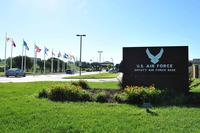WASHINGTON – An Atlas V rocket launched Thursday night from Vandenberg Air Force Base, Calif., carried a U.S. Southern Command-sponsored nanosatellite into space -- and with it, the potential for more reliable and less expensive communications for troops around the world.
The nanosatellite, about the size of a loaf of bread and weighing just 11 pounds, piggybacked during the launch on a payload for the National Reconnaissance Office headquartered in Chantilly, Va., Southcom officials said.
That small package carries big hopes for Southcom, which spearheaded the demonstration project to help overcome communications challenges in the vast mountainous and densely forested terrain within Latin America, Juan Hurtado, Southcom’s science and technology advisor, told American Forces Press Service during an interview from Vandenberg Air Force Base.
As envisioned, troops on the ground will be able to tap the new technology directly from their field radios. And when the satellite moves beyond the part of the globe beyond Southcom’s area of responsibility, it could provide that same capability to other combatant commands as well, Hurtado said.
“This is a major milestone,” he said. “This first space project for U.S. Southern Command represents a big step ahead. I feel like we are about ready to offer a transformational capability to support troops in the field, not just within Southern Command, but throughout the Department of Defense.”
“This is just an evaluation, but we think this space capability could help improve communication during various operations,” said Marine Corps Gen. John F. Kelly, Southcom’s commander.
If the initial phase of the demonstration goes as hoped, two additional nanosatellites will launch next December, Hurtado reported.
All three will be set to a low-earth orbit, operating as one component of a communications suite to include a ground station, ground sensors and tactical radios, he explained. Collectively, they will support information-sharing and tactical communications over wide geographic expanses.
The development and deployment of the nanosatellites represent the strength of partnerships at several levels, Hurtado said.
U.S. Army Space and Missile Defense Command oversaw its development, and the Defense Department funded it through its Joint Capability Technology Demonstration effort. Cadre and students at the U.S. Naval Postgraduate School will help Southcom assess the technology’s operational value.
In addition, Southcom’s counterparts in Brazil and Peru will help evaluate its performance. Hurtado is headed to both countries next week to discuss details about how the three countries will work together during the demonstration.
Kelly called the investment in nanosatellites “an opportunity for us to collaborate from the ground up with partner nations who are looking to develop this capability for a variety of security and commercial uses.”
The initial concept for the nanosatellite originated through close collaboration among the Secretary of Defense’s Rapid Fielding Directorate, Army Space and Missile Defense Command and Southcom’s science, technology and experimentation office.
Since it was stood up in 2002, the Southcom office has helped to identify technical capabilities to support the command’s mission, and lacking them, helped to develop new ones, Hurtado said. Its staff takes gaps and requirements as identified by U.S. forces and partner nations in the theater, converts them into technical requirements, then looks initially to the DoD technical technology community for solutions.
The original objective -- “to find ways to do things better or do things cheaper” -- is even more pressing in today’s fiscal environment, Hurtado noted.
The new nanosatellite offers promise on both counts. It cost $500,000 to build, far less than larger satellites, and its small size makes launching it into space relatively inexpensive. Both factors could make it feasible to deploy several nanosatellites as needed to expand communication coverage to ground forces in support of an array of mission requirements, including humanitarian assistance and disaster response operations, Hurtado said.
He emphasized however, that last night’s launch is just the start of a long evaluation process ahead. The first of two evaluations, planned for May, will take three months to complete. A final evaluation scheduled for February 2015 will span five months using all three satellites.
“Recognizing that, I feel extremely proud of this effort and the potential capability it stands to offer for our forces,” Hurtado said. “This will make communications not only less expensive, but more readily available.”






















